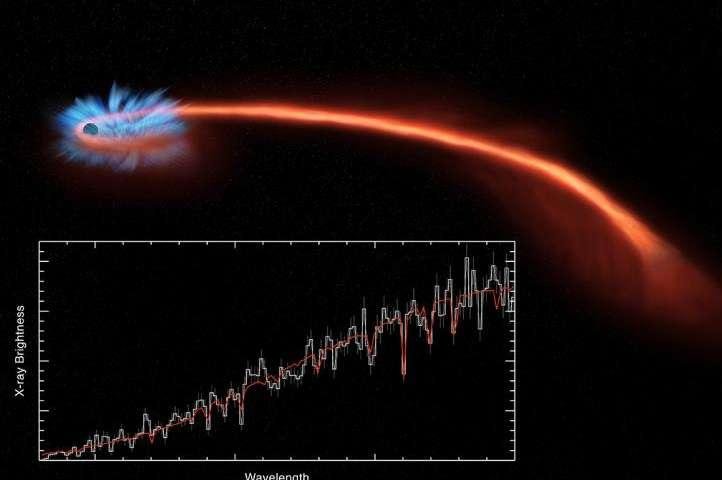An illustration shows what the recent tidal disruption, named ASASSN-14li, looked like. Stellar material was shredded and ejected as the star began to be sucked down into the supermassive black hole. Photo by NASA/CXC/M. Weiss
SANTA CRUZ, Calif., Oct. 21 (UPI) -- Last year, an unsuspecting star came too close to a supermassive black hole at the center of the galaxy PGC 043234.
What happened next wasn't pretty. The star came to a violent end, ripped to shreds by the powerful gravitational forces of the black hole -- an event know as a tidal disruption.
Such events happen regularly in the universe, but this time, astronomers happened to be watching. Several telescopes -- NASA's Chandra X-ray Observatory, Swift Gamma-ray Burst Explorer, and ESA's XMM-Newton -- were trained on the galaxy's center, capturing the unique event and revealing in detail what exactly happens when a black hole eats a star.
What happens is spaghettification. The tidal forces exerted on the star by the black hole's powerful gravity cause the stellar material to be torn into thin, noodle-like fragments. Some the stellar debris on the side of the star farthest from the black hole was flung out into space; the rest was sucked down into the black hole.
The tidal disruption event, named ASASSN-14li, resulted in two types of radiation -- X-rays and optical light. The X-rays are emitted from the "event horizon" where stellar debris is burned up in the black hole's accretion dish. The optical radiation is the result of X-rays that are absorbed by expelled debris and re-emitted as longer wavelengths.
Scientists Enrico Ramirez-Ruiz and James Guillochon, from the University of California, Santa Cruz, had previously theorized the emission of these two types of radiation, but they had only witnessed the optical flare. The ASASSN-14li event proved their theory correct.
"The black hole is behind a cloak of debris that changes its appearance, but now we are able to see the inner beast," Ramirez-Ruiz, a professor of astronomy and astrophysics, said in a press release. "James and I had predicted that we should be able to see both x-ray and optical emissions."
Guillochon, who was a graduate student when he helped Ramirez-Ruiz develop the theory, is now a researcher at Harvard University.
An analysis of the unique tidal disruption was published in the journal Nature this week.
"We have seen evidence for a handful of tidal disruptions over the years and have developed a lot of ideas of what goes on," said study leader Jon Miller, an astrophysicist at the University of Michigan. "This one is the best chance we have had so far to really understand what happens when a black hole shreds a star."
Researchers hope to find more disruption events like ASASSN-14li so they can continue to test their black hole theories and come to better understand how these mysterious objects affect space.















